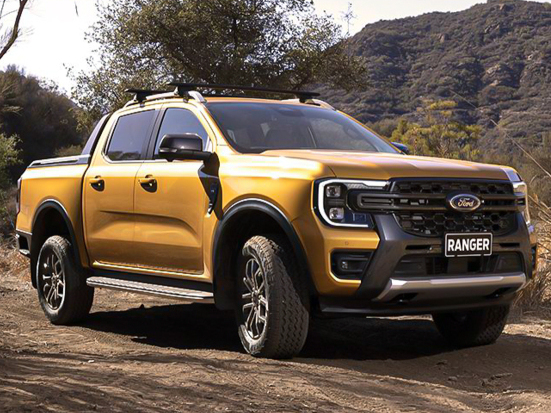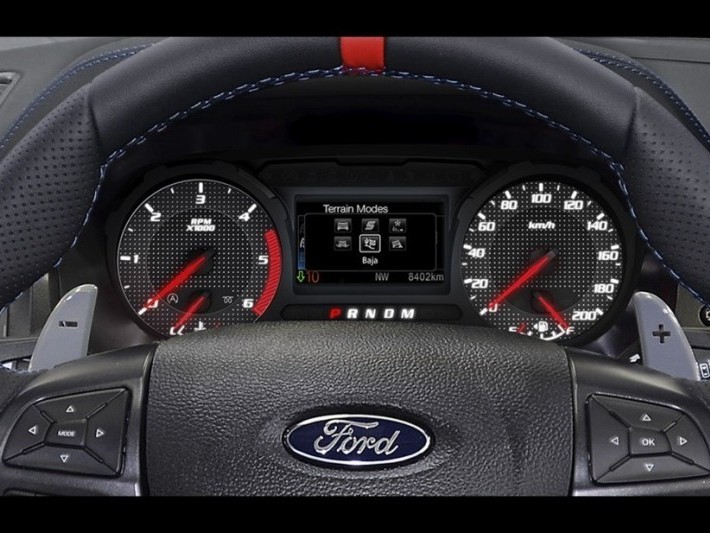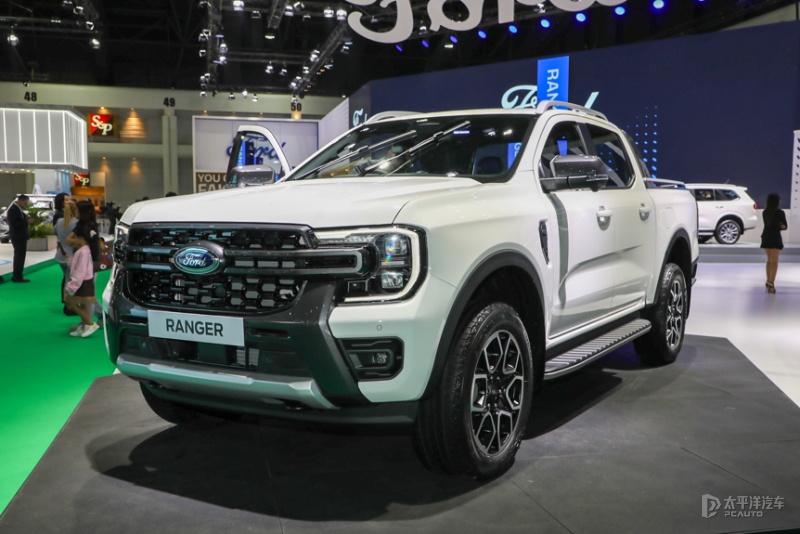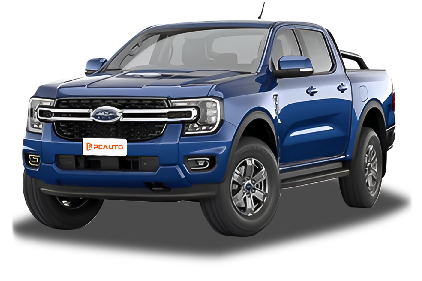Q
What kind of transmission does a 2020 Ford Ranger have?
The 2020 Ford Ranger offers two transmission choices: a 6-speed automatic and a 6-speed manual, with specific availability depending on the trim level and powertrain. The Wildtrak trim, which comes with the 2.0-liter bi-turbo diesel engine, comes standard with the 6-speed automatic, while some entry-level models might get the 6-speed manual to suit different driving preferences. The automatic transmission uses electronically controlled shifting, which optimizes fuel efficiency and smoothness—perfect for city commuting and long highway drives. On the other hand, the manual gearbox is better for drivers who crave that hands-on feel, delivering more direct power delivery and driving engagement. Both transmissions are finely tuned to match the Ranger's off-road capabilities, handling everything from daily errands to rough terrain with ease. They stand out for their durability and reliability in the segment, and regular maintenance will keep them running strong for the long haul. If you're often towing heavy loads or hitting the trails, the automatic's convenience might be more your style, but the manual brings that extra level of driver involvement. Understanding how each transmission performs can help you pick the setup that best fits your driving habits and get the most out of your Ranger.
Special Disclaimer: This content is published by users and does not represent the views or position of PCauto.
Related Q&A
Q
What are the cons of the 2020 Ford Ranger?
The 2020 Ford Ranger is a solid-performing pickup, but there are a few drawbacks worth noting. First off, fuel economy is just so-so, especially with the 2.0L twin-turbo diesel engine – it guzzles more gas around town, which could hike up running costs for folks who do a lot of highway driving. Then there's the rear seat space, which feels pretty tight, especially legroom-wise; taller passengers might find it cramped, making long drives less comfy. Inside, the cabin uses a lot of hard plastics on the center console and door panels, so the overall feel isn't as premium as some competitors in its class. Tech-wise, the base trim's infotainment system is pretty basic – you don't get Apple CarPlay or Android Auto, those mainstream connectivity features, unless you step up to a higher trim. At highway speeds, wind and road noise can get noticeable too. And being a pickup, it's got leaf springs in the rear suspension, which means the back seat ride can feel bumpy when the truck's empty. That said, the Ranger still shines when it comes to off-roading and hauling. Its smart 4WD system and multiple drive modes handle tough terrain well, and the bed can carry a decent load. For buyers needing a truck that works hard during the week and can hit the trails on weekends, it's still a solid pick – just something to weigh up before signing on the dotted line.
Q
How long will my 2020 Ford Ranger last?
A 2020 Ford Ranger, when used normally and serviced regularly, can typically last 200,000 to 300,000 kilometers or even longer. Its actual lifespan depends on driving habits, road conditions, and how often you get it serviced. The diesel engines in this truck are known for durability, especially the 3.2-liter five-cylinder and 2.0-liter bi-turbo versions. Keep up with oil changes, filter replacements, and timing belt services, and the engine should stay pretty reliable.
In terms of body structure, the Ranger uses high-strength steel and rust-proofing, which helps slow down corrosion even in our local humid climate. Still, it’s a good idea to wash the undercarriage regularly, especially after driving in the rainy season or near the coast. The transmission and 4WD system also need regular fluid checks—try not to overdo it with off-roading or heavy loads. If you notice strange noises, reduced power, or a sudden jump in fuel consumption, get it checked out right away. Letting those small issues slide can lead to bigger, costlier problems down the line.
The key to making your Ranger last is sticking strictly to the maintenance schedule in the owner’s manual and using OEM or certified parts. Also, avoid keeping it under heavy load for long stretches. Electronic system stability matters for long-term use too—update the infotainment software periodically and keep an eye on the battery health. All in all, the Ranger holds up well against other pickups in its class; plenty of owners are still running theirs smoothly even after 10 years on the road.
Q
What is the powertrain warranty on a 2020 Ford Ranger?
The 2020 Ford Ranger typically comes with a powertrain warranty of 5 years or 160,000 kilometers, whichever comes first. This warranty covers core components like the engine, transmission, and drivetrain, giving owners peace of mind for the long haul. The powertrain warranty is a key part of a vehicle's coverage and usually lasts longer than the basic warranty, showing the manufacturer's confidence in these critical parts. While different brands might define "powertrain" slightly differently, it generally includes major components such as the engine, transmission, driveshaft, and differential. Beyond the factory warranty, owners can opt for extended warranty plans for extra protection—especially handy if you regularly do heavy off-roading or hauling. Sticking to regular maintenance at authorized service centers is a must to keep the warranty valid; using non-genuine parts or skipping required servicing could void it. Knowing your vehicle's warranty coverage helps you file claims promptly when issues pop up, saving you from unexpected repair bills. And it's a good idea to keep all your service records as proof, just in case.
Q
Does the 2020 Ford Ranger have any problems?
The 2020 Ford Ranger is generally a reliable pickup, but some owners have reported common issues during use. For example, the transmission occasionally has a jerky feel at low speeds, which might be due to its tuning leaning towards fuel efficiency. Additionally, some owners have mentioned that electronic systems like the infotainment screen can sometimes lag or freeze; these problems can usually be fixed with a software update. In terms of power, the 2.0-liter bi-turbo diesel engine performs strongly, but regular maintenance is recommended to ensure its long-term stability, especially timely replacement of the diesel filter. The body structure and chassis excel in harsh road conditions, but it's advisable to regularly inspect the suspension components, as pickup trucks often carry heavy loads or are used for off-roading, which can accelerate component wear. It's worth mentioning that this vehicle has great modification potential, with many upgrade accessories available on the market for off-road or cargo needs, but it's recommended to choose professional manufacturers for modifications to ensure it doesn't affect the original vehicle warranty and safety. Overall, as long as regular maintenance is carried out according to the manufacturer's recommendations, this vehicle can provide good durability and practicality, suitable for consumers who need to balance daily use and work needs.
Q
What is the recall on Ford trucks 2020?
The 2020 Ford truck recalls, covering models like the F-150 and Super Duty lineup, primarily address potential safety concerns. These include issues where some vehicles' driveshafts might fracture due to improper heat treatment, leading to a loss of power transmission. Additionally, certain trucks could experience delayed or failed rearview camera displays caused by wiring problems, which poses a risk during reversing maneuvers. To tackle these problems, Ford is offering free replacements of upgraded components or software updates through its dealerships for affected vehicles. If you're an owner suspecting your truck might be part of the recall, you can verify by checking your Vehicle Identification Number (VIN) on Ford's official website or by visiting an authorized service center. It's important to note that vehicle recalls are a standard practice for manufacturers to proactively resolve potential defects, not an indication of poor quality. In fact, they demonstrate a brand's commitment to safety. During daily driving, regularly inspecting your vehicle's condition and promptly responding to recall notices can effectively reduce risks. It's also advisable to get in the habit of subscribing to recall alerts through official channels to ensure you receive the latest information as soon as it's available.
Q
What type of transmission does a 2020 Ford Ranger have?
The 2020 Ford Ranger offers two transmission options: a 6-speed automatic and a 6-speed manual. The specific configuration depends on the trim level and powertrain, with the automatic version being more common. This automatic gearbox is widely praised for its smooth shifts and reliability, making it a solid choice for daily driving and light off-roading. The Ranger's automatic transmission uses advanced shift logic that adjusts shift points based on driving conditions, boosting fuel economy and enhancing the overall driving experience. On the other hand, the manual transmission caters more to drivers who crave that hands-on, engaging feel. As a core component of the vehicle, the transmission directly impacts driving dynamics and fuel efficiency. Regular maintenance and transmission fluid changes are key to extending its lifespan, so it's best to follow the manufacturer's recommended service intervals. For users who frequently go off-roading or haul heavy loads, opting for a trim with a more robust, reinforced transmission is a smart move to ensure long-term durability.
Q
What is the transmission problem on the 2020 Ford F-150?
The 2020 Ford F-150 has had some reported transmission issues, mainly with the 10-speed automatic (10R80). Some owners have noted rough shifting or delays at low speeds, especially noticeable during cold starts or frequent acceleration/deceleration. Additionally, there are a few cases mentioning potential abnormal noises from the transmission under specific operating conditions. These problems can usually be improved through software updates or resetting the transmission's adaptive learning program; if there's hardware damage, relevant components may need replacement. Ford has issued Technical Service Bulletins (TSBs) addressing these issues, advising owners to perform regular maintenance and promptly visit authorized service centers for inspections. Transmission technology has advanced rapidly in recent years; 10-speed transmissions improve fuel economy and smoothness through closer gear ratios, but their complex design demands higher manufacturing precision and maintenance standards. In daily driving, avoiding sudden acceleration/deceleration and regularly changing the specified transmission fluid can effectively extend its lifespan. If you encounter similar problems, prioritizing connecting professional diagnostic equipment to read trouble codes will help quickly identify the cause.
Q
What is the Ford engine recall in 2020?
The 2020 Ford engine recall affects certain models worldwide equipped with the 1.5-liter EcoBoost engine. The main issue is that coolant may leak into the cylinders, causing the engine to overheat or stall, posing a safety risk. Affected vehicles include SUV models like the KUGA (the overseas version of the Escape). Ford is offering free inspection and repair services, including replacing core components such as the cylinder block to ensure the cooling system's seal performance. This type of recall is a regular part of automakers' proactive problem-checking processes, reflecting a responsible attitude towards consumers. For car owners, if the dashboard indicates an engine fault or abnormal coolant loss, they should promptly contact an authorized service center for inspection. In fact, engine cooling system failures are one of the common issues in the automotive industry. Regularly checking coolant levels and hose seal performance helps prevent such situations. Different brands and models may also have similar technical risks due to design differences, so developing good regular maintenance habits is very important.
Q
What is the transmission problem on the 2020 Ford Super Duty?
The transmission issues with the 2020 Ford Super Duty primarily center around the 10-speed automatic transmission (10R140). Some owners have reported rough shifting, delayed upshifting or downshifting, and jerking during low-speed driving. These problems may be related to transmission software calibration or the hydraulic control system. Ford has issued a technical bulletin advising dealers to update the Transmission Control Module (TCM) program to optimize shift logic. Additionally, a small number of cases mention that a faulty transmission oil temperature sensor causes the warning light to illuminate. Such issues typically require inspecting the sensor wiring or replacing the component. For heavy-duty pickup trucks, transmission durability is crucial. In daily use, it is advisable to avoid frequent rapid acceleration or overloading, check the transmission fluid condition and level during regular maintenance, and promptly visit an authorized service center for diagnosis if abnormal noises or shifting problems are noticed. Modern transmission technology is complex; software updates are often the preferred solution for electronic issues, while mechanical components require professional equipment for testing. Maintaining good driving habits can significantly extend the transmission's lifespan.
Q
How long is the warranty on a 2020 Ford Ranger?
The 2020 Ford Ranger comes with a factory warranty of 3 years or 100,000 kilometers, whichever comes first. This warranty covers the vehicle's major mechanical components and electronic systems, providing owners with basic quality assurance. It's worth noting that some wear - and - tear parts like brake pads, windshield wipers, and tires are usually not covered. For specific details, it's advisable to refer to the warranty manual provided at the time of purchase. In addition to the factory warranty, many dealers offer extended warranty service options, and owners can choose to purchase them according to their own needs to further extend the coverage period. During the warranty period, it's crucial to have regular maintenance at authorized service centers; otherwise, it may affect the warranty rights. For pickup trucks that are often used for hauling or off - road driving, it's recommended that owners carefully read the instructions on usage conditions in the warranty terms, as some extreme usage scenarios may invalidate the warranty. Understanding these details can help owners better protect their rights and keep the vehicle in optimal condition.
Latest Q&A
Q
Is the 2021 Arteon an improvement?
The 2021 Arteon has indeed received upgrades in several areas, making it more competitive than its predecessor. The exterior retains the sleek lines of a coupe, but the front grille and LED headlight designs are sharper. Inside, it gets a new-generation digital cockpit, featuring a standard 10.3-inch fully digital instrument cluster and a 9.2-inch central control screen. It also upgrades to the MIB3 infotainment system, supporting wireless Apple CarPlay and Android Auto, significantly enhancing the tech feel. Under the hood, it offers the proven combination of a 2.0T turbocharged engine paired with a 7-speed DSG transmission, and some markets even add a plug-in hybrid version for a balance of performance and fuel efficiency. In terms of safety, the entire lineup comes standard with the Travel Assist semi-autonomous driving assistance system, which includes lane-keeping and adaptive cruise control, meeting current mainstream demands. Notably, the introduction of the Arteon Shooting Brake expands the model range, with the trunk space increasing to 1632 liters for significantly improved practicality. This type of coupe model is gaining popularity locally, as it satisfies both design aspirations and family needs. Arteon's facelift clearly addresses these key points, especially the enhanced digital features that keep it in step with the times.
Q
What engine is in the 2021 Arteon?
The 2021 Arteon offers two turbocharged engine options across different markets. The mainstay powerplant is the 2.0-liter TSI four-cylinder gasoline engine, churning out 272 horsepower and 350 Nm of peak torque, paired with a 7-speed DSG dual-clutch transmission. This powertrain strikes a balance between performance and fuel efficiency, sprinting from 0-100km/h in just 5.8 seconds. Some markets also get the more entry-level 1.5-liter TSI EVO engine variant, featuring active cylinder management technology. It's worth noting that the model is built on Volkswagen Group's modular transverse platform (MQB), with a front-engine, front-wheel-drive layout. Higher trim levels come equipped with the 4MOTION permanent all-wheel-drive system. This powertrain setup shares technology with the Golf R but is tuned more for comfort. As the successor to the Volkswagen CC, the Arteon's EA888 series engine has been re-optimized, incorporating advanced technologies like a dual-injection system and an integrated cylinder head. It's recommended to use 95 octane or higher gasoline for optimal performance, and regular maintenance is suggested every 15,000 kilometers or 12 months, whichever comes first.
Q
What is the difference between 2021 and 2022 Arteon?
The main differences between the 2021 and 2022 Arteon lie in upgraded features and detailed refinements, with the 2022 model stepping up its tech game and driver assistance capabilities. The 2022 Arteon comes standard with the new-generation infotainment system, boasting faster screen response and wireless Apple CarPlay and Android Auto support – features that were optional on some 2021 trims. On the safety front, the 2022 model adds Travel Assist, which combines adaptive cruise control and lane-keeping assist for easier long drives, while some variants also get a 360-degree camera. Externally, new wheel designs are on offer for 2022, and there are minor tweaks to interior materials, like more exquisite seat stitching craftsmanship is even more refined. Under the hood, things stay the same – both model years still offer the 1.5T and 2.0T engine options. It’s worth noting that these annual updates usually don’t mess with core components; instead, they boost competitiveness by adding previously optional features as standard or refining interfaces. When shopping, keep an eye on dealer discounts for leftover 2021 stock – sometimes you can score a better value that way. Also, the used car retention value between these annual refresh models typically isn’t huge; it mostly depends on specific features and overall condition.
Q
How much is a 2021 Arteon worth?
The 2021 Arteon is currently fetching around RM150,000 to RM200,000 on the used car market, with prices varying based on condition, mileage, trim level, and whether it's still under the original factory warranty. As Volkswagen's flagship coupe, the Arteon stands out with its sleek frameless doors, a 2.0TSI turbo engine pumping out around 280 horsepower, and a digital cockpit. Higher-spec models might also come with the 4MOTION all-wheel-drive system and DCC adaptive chassis. It’s worth noting that German cars like this tend to have slightly higher maintenance costs than their Japanese counterparts, but the factory-backed 5-year unlimited mileage warranty (if still valid) can really cut down on long-term ownership expenses. If you’re considering a used Arteon, it’s smart to prioritize certified pre-owned units or those with complete service records. Also, check the maintenance history of the EA888 engine and the transmission fluid change records for the 7-speed DSG (which is most common). In the same price range, you could also look at the BMW 4 Series Gran Coupe or Mercedes-Benz CLA Shooting Brake from the same year, but the Arteon has the edge when it comes to space and practicality—perfect for buyers who want both style and functionality.
Q
Is a 2021 Volkswagen Arteon a good car?
The 2021 Volkswagen Arteon is a solid all-around performer. It boasts an elegant coupe-like design, a roomy interior, and a refined powertrain. Under the hood, you'll find a 2.0-liter turbocharged engine that delivers plenty of power and a relatively smooth driving experience, making it suitable for both daily commuting and long road trips. Inside, the Arteon features high-quality materials and a generous array of tech, including a digital gauge cluster and a large infotainment screen. It also supports advanced driver assistance features, which boost both safety and convenience. However, its fuel economy might not stack up as well against some Japanese rivals, and maintenance costs are a bit on the higher side—typical traits for German cars. If you value sleek design and driving dynamics, the Arteon is definitely worth a look. But if fuel efficiency is your top priority, you might want to cross-shop comparable Japanese or Korean models. Also, if you're considering a used Arteon, make sure to check the service records and overall condition to avoid potential issues. German cars tend to have more complex electronic systems, so regular maintenance is crucial.
View MoreRelated News

2025 Ford Ranger WildTrak launched, the most powerful diesel version in the Ranger lineup
MichaelAug 25, 2025

Is the Ford Ranger V6 about to enter Malaysia?
LienAug 13, 2025

Reviewing the Ford Ranger: The Dual Advantages of Rugged Appearance and Powerful Performance
Kevin WongApr 21, 2025

"Starting from RM 170,888! Detailed Explanation of Ford Ranger's Configuration and Performance, a Synonym for Practicality and Versatility?"
AshleySep 20, 2024

Ford Ranger: A Safe, Reliable, and Economical Choice of Pickup
LienMay 2, 2024
View More
















Pros
Cons